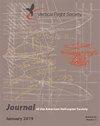基于几何精确梁的复合材料桨叶前飞气动弹性建模与求解
IF 1.4
4区 工程技术
Q2 ENGINEERING, AEROSPACE
引用次数: 2
摘要
本文采用最新的变分渐近梁截面分析(VABS)建立了复合材料动叶前飞的几何精确梁模型和气动弹性求解方法。采用混合变分形式的几何精确梁运动方程和最新的VABS分别处理叶片的一维分析和叶片截面的结构特性。该方法可用于具有任意横截面形状和材料分布、大挠度和由材料各向异性引起的截面翘曲、横向剪切变形和弹性耦合等显著非经典效应的复合材料动叶气动弹性解。采用Peters - he有限状态动态入流模型和Peters有限状态气动载荷理论分别计算了诱导速度和叶片气动载荷。一个自动驾驶修剪方案用于计算桨距控制,以满足修剪要求。成功地解决了求解几何精确的混合变分气动弹性方程时遇到的收敛问题。所提出的气动弹性模型的自动驾驶配平方案中经验参数的取值选择合理。通过SA349/2飞行试验数据,验证了气动弹性建模和求解方法的准确性。研究了横向剪切变形对复合材料动叶气动弹性响应的影响,表明横向剪切变形对本文研究的五种不同类型的弹性耦合无铰复合材料动叶气动弹性响应具有不可忽略的影响。本文章由计算机程序翻译,如有差异,请以英文原文为准。
Geometrically Exact Beam-Based Aeroelastic Modeling and Solution of Composite Rotor Blades in Forward Flight
In this paper, the geometrically exact beam model and aeroelastic solution methods for composite rotor blades in forward flight by the latest variational asymptotic beam sectional analysis (VABS) have been employed. The geometrically exact beam equations of motion in the mixed variational form and the latest VABS are used to deal with one-dimensional blade analysis and the structural property of blade cross section, respectively. The methods can be used for the aeroelastic solution of composite rotor blades with arbitrary cross-sectional shape and material distribution, large deflections and significant nonclassical effects such as cross-sectional warping, transverse shear deformation, and elastic couplings caused by anisotropic material properties. The Peters–He finite state dynamic inflow model and the Peters finite state airloads theory are used to calculate the induced velocity and blade airloads, respectively. An auto-pilot trim scheme is used for calculating the blade pitch controls to meet the trim requirements. The convergence issue encountered when solving the geometrically exact, mixed variational aeroelastic equations in time domain has been successfully addressed. The values of the empirical parameters in the auto-pilot trim scheme for the presented aeroelastic model have been properly selected. The accuracy of the presented aeroelastic modeling and solution methods has been verified against the SA349/2 flight-test data. The influence of transverse shear deformation on the aeroelastic response of composite rotor blades was also investigated, indicating that this effect has a nonnegligible influence on the aeroelastic response of the five different kinds of elastically coupled hingeless composite rotors investigated in this paper.
求助全文
通过发布文献求助,成功后即可免费获取论文全文。
去求助
来源期刊

Journal of the American Helicopter Society
工程技术-工程:宇航
CiteScore
4.10
自引率
33.30%
发文量
36
审稿时长
>12 weeks
期刊介绍:
The Journal of the American Helicopter Society is a peer-reviewed technical journal published quarterly (January, April, July and October) by AHS — The Vertical Flight Society. It is the world''s only scientific journal dedicated to vertical flight technology and is available in print and online.
The Journal publishes original technical papers dealing with theory and practice of vertical flight. The Journal seeks to foster the exchange of significant new ideas and information about helicopters and V/STOL aircraft. The scope of the Journal covers the full range of research, analysis, design, manufacturing, test, operations, and support. A constantly growing list of specialty areas is included within that scope. These range from the classical specialties like aerodynamic, dynamics and structures to more recent priorities such as acoustics, materials and signature reduction and to operational issues such as design criteria, safety and reliability. (Note: semi- and nontechnical articles of more general interest reporting current events or experiences should be sent to the VFS magazine
 求助内容:
求助内容: 应助结果提醒方式:
应助结果提醒方式:


